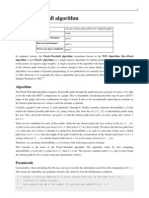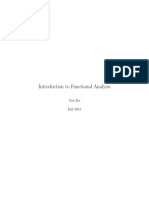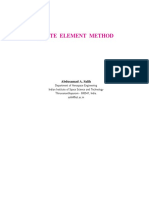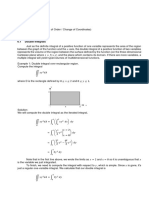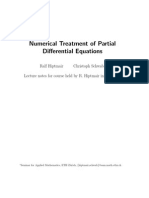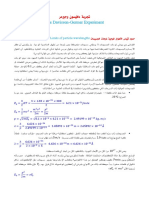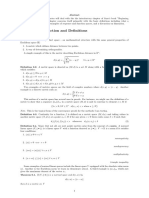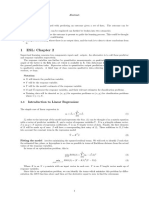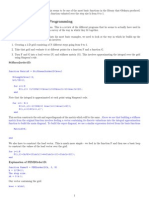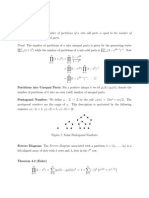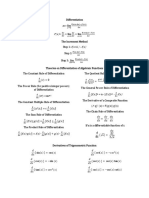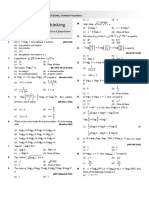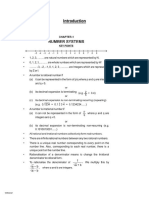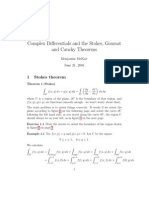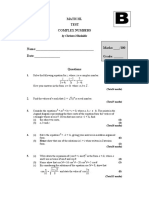Fact Sheet Functional Analysis
Literature:
Hackbusch, W.: Theorie und Numerik elliptischer Dierentialgleichungen. Teubner, 1986.
Knabner, P., Angermann, L.: Numerik partieller Dierentialgleichungen. Springer, 2000.
Triebel, H.: Hohere Analysis. Harri Deutsch, 1980.
Dobrowolski, M.: Angewandte Funktionalanalysis, Springer, 2010.
1. Banach- and Hilbert spaces
Let V be a real vector space.
Normed space: A norm is a mapping : V [0, ), such that:
u = 0 u = 0, (deniteness)
u = || u, R, u V, (positive scalability)
u +v u +v, u, v V. (triangle inequality)
The pairing (V, ) is called a normed space.
Seminorm: In contrast to a norm there may be elements u = 0 such that u = 0. It
still holds u = 0 if u = 0.
Comparison of two norms: Two norms
1
,
2
are called equivalent if there is a
constant C such that:
C
1
u
1
u
2
Cu
1
, u V.
If only one of these inequalities can be fullled, e.g.
u
2
Cu
1
, u V,
the norm
1
is called stronger than the norm
2
.
2
is called weaker than
1
.
Topology: In every normed space a canonical topology can be dened. A subset U V
is called open if for every u U there exists a > 0 such that
B
(u) = {v V : u v < } U.
Convergence: A sequence v
n
converges to v w.r.t. the norm if
lim
n
v
n
v = 0.
1
A sequence v
n
V is called Cauchy sequence, if sup{v
n
v
m
: n, m k} 0 for
k . A normed space is called complete if every Cauchy sequence converges to an
element v V . A Banach space is a complete normed space.
Bilinear form: A bilinear form is a mapping (, ) : V V R which is linear in each
argument:
a(u, v
1
+v
2
) = a(u, v
1
) +a(u, v
2
), u, v
1
, v
2
V, R,
a(u
1
+u
2
, v) = a(u
1
, v) +a(u
2
, v), u
1
, u
2
, v V, R.
The bilinear form (, ) is called
symmetric, if (u, v) = (v, u), u, v V ,
positive, if (v, v) 0, v V ,
denite, if (u, u) = 0 u = 0.
Hilbert space: A symmetric, positive denite bilinear form is called inner product. A
inner product induces a norm on V by u :=
_
(u, u). If the bilinear form is not denite,
it only induces a seminorm. A space which is endowed with a inner product and complete
with respect to the induced norm is called Hilbert space.
Important properties of a (semi-)norm which is induced by a inner product:
a) CauchySchwarz-inequality:
|(u, v)| u v, u, v V,
b) parallelogram equation:
u v
2
+u +v
2
= 2(u
2
+v
2
)
hold.
c) Any norm fullling the parallelogram equation is induced by a inner product:
(u, v) =
1
4
(u +v
2
u v
2
).
2. Sobolev spaces
Lipschitz domain: The domain is said to have a Lipschitz boundary if for some
N N there are open sets U
1
, U
2
, . . . , U
N
such that
2
a)
N
i=1
U
i
b) For each i = 1, . . . , N the part of the boundary U
i
can be represented as a
graph of a function which is Lipschitz continuous.
A domain with a Lipschitz boundary is called Lipschitz domain.
Example:
The following domain is an example of a domain without a Lipschitz boundary
Now, let R
d
be a bounded domain with Lipschitz boundary = .
L
1
loc
() is the linear space containing all functions which are Lebesgue integrable on every
compact subset of .
L
2
() is the linear space containing all functions which are Lebesgue square integrable
on . Endowed with the inner product
(u, v)
0
=
_
uv
and the induced norm
v
0
=
_
(v, v)
0
,
it is a Hilbert space.
Weak derivative: Consider a function u L
1
loc
(). We say that v L
1
loc
() is the
th
-weak derivative of u, if
_
v = (1)
||
_
uD
, C
0
().
We use the notation
D
=
||
1
1
. . . x
n
n
,
for a multi-index = (
1
. . .
n
), where || =
i
N
0
. C
0
() is the linear space of all
innitely dierentiable functions with a compact support in .
We denote D
u := v.
Sobolev-space: For k N
0
, set
H
k
() := {v L
2
() : D
v L
2
(), || k}.
It holds: H
0
() = L
2
().
Example:
Consider = B(0,
1
2
), s R and u(x) = |x|
s
.
3
For s = 1 we have u H
1
() and the rst weak derivative is given by
Du(x) =
_
1, 0.5 < x < 0
1, 0 < x < 0.5
.
0 100 200 300 400 500 600 700 800 900 1000
0
0.05
0.1
0.15
0.2
0.25
0.3
0.35
0.4
0.45
0.5
s = 1 ; alpha = 0
0.5 0.4 0.3 0.2 0.1 0 0.1 0.2 0.3 0.4 0.5
1.5
1
0.5
0
0.5
1
1.5
s = 1 ; alpha = 1
For s =
1
2
we have u / H
1
() and the rst weak derivative is given by
Du(x) = |x|
0.5
/ L
2
().
0 100 200 300 400 500 600 700 800 900 1000
0
0.1
0.2
0.3
0.4
0.5
0.6
0.7
0.8
s = 0.5; alpha = 0
0 100 200 300 400 500 600 700 800 900 1000
0
5
10
15
20
25
30
35
40
45
s = 0.5 ; alpha = 1
The linear space H
k
() is a Hilbert space endowed with the inner product
(u, v)
k
=
||k
(D
u, D
v)
0
,
and the induced norm
v
k
=
_
(v, v)
k
.
Examples:
L
2
orH
0
-norm : u
2
0
=
_
u
2
,
H
0
-seminorm : |u|
2
0
= u
2
0
,
H
1
-norm : u
2
1
= u
2
0
+u
2
0
,
H
1
-seminorm : |u|
2
1
= u
2
0
,
H
k
-norm : u
2
k
= u
2
k1
+
||=k
D
u
2
0
.
4
Important dense embedding: The set C
()H
k
() is dense in H
k
(). Thus H
k
()
is the completion of the linear space {v C
() : v
k
< } in L
2
() with respect to
the norm
k
.
Zero-boundary conditions: The linear space H
k
0
() is dened as the completion of the
space C
0
() in L
2
() with respect to the norm
k
.
Poincare-Friedrichs-inequality: There exists a constant C such that
v
k1
C|v|
k
, v H
k
0
().
Hence in H
k
0
() the norm
k
and the seminorm | |
k
are equivalent.
Further norm-equivalences:
v
2
1
|v|
2
1
+
__
v
_
2
, v
2
1
|v|
2
1
+
__
D
v
_
2
,
where
D
has a positive measure.
3. Trace-, Extensions- and Embedding theorems, Dual spaces
Sobolev-Slobodeckij-space: For s > 0, s N
0
, where s = k + t, k N
0
, 0 < t < 1,
dene
H
s
() = {v H
k
() : I
t
(D
v) < , || = k},
where I
t
(w) =
_
(w(x) w(y))
2
x y
d+2t
dxdy.
Example:
Consider = (1, 1) and v(x) =
_
1, x > 0
0, x 0.
Question: For which s 0 is v H
s
() fullled? We already know v H
0
(), v /
H
1
().
5
I
s
(v) =
_
1
1
_
1
1
(v(x) v(y))
2
|x y|
1+2s
dx dy
=
_
0
1
_
0
1
. . .
. .
=0
+
_
0
1
_
1
0
+
_
1
0
_
0
1
+
_
1
0
_
1
0
. . .
. .
=0
= 2
_
0
1
_
1
0
1
|x y|
1+2s
dx dy
= 2
_
0
1
1
2s
1
(x y)
2s
|
1
0
dy
=
1
s
__
0
1
1
|1 y|
2s
dy
_
0
1
1
|y|
2s
dy
_
.
Thus I
s
(v) < for s <
1
2
and v H
s
() for all 0 s <
1
2
.
Trace theorem: There is a unique linear mapping
tr : H
1
() H
1/2
()
such that tr (u) = u|
, for all u H
1
() C(
).
Remarks:
For u H
1
(), there exists a sequence u
n
C() such that u
n
u, tr (u
n
)
tr (u).
The mapping tr is surjective (onto H
1/2
()), but not injective.
For s > 1/2 we have tr : H
s
() H
s1/2
().
H
1
0
() = {v H
1
() : tr v = 0}.
Example:
Consider
=
_
(x, y) R
2
| 0 < x < 1 0 < y < x
4
_
= (0, 1) {0}.
is not a Lipschitz domain. For u : R,
u(x, y) =
1
x
,
it holds u / L
2
(), but u H
1
(), as
_
u
2
(x, y)dx dy =
_
1
0
1
|x|
2
dx
= lim
0
_
1
1
x
2
dx = lim
0
_
1
x
_
1
= ,
6
and
_
|Du(x, y)|
2
dx dy =
_
1
0
_
x
4
0
|
1
x
2
|
2
dy dx
=
_
1
0
|
1
x
2
|
2
x
4
dx =
_
1
0
1 dx = 1 < .
We see, that the trace theorem is not valid!
Extension theorem: For any u H
1/2
() there is a v H
1
() such that
tr (v) = u and v
1,
Cu
1/2,
Remarks:
The extension operator is not unique.
For s > 1/2 it maps u H
s1/2
() v H
s
().
Sobolev lemma:
H
s
(R
d
) C
k
(R
d
), s > k +d/2,
H
s
() C
k
(), s > k +d/2.
Compact embedding:
A Banach space V is said to be compactly embedded in a Banach space W (V
K
W) if
every sequence v
n
V , v
n
V
1 contains a subsequence which is convergent in W. It
holds:
H
s
0
()
K
H
t
0
(), s, t R, s > t,
H
k
()
K
H
(), k, N
0
, k > .
Dual space:
Given a real vector space V , we call V
the dual space, i.e. the space of all continuous,
linear mappings from V onto R. If V is a normed space, the dual norm
V
= sup
vV
(v)
v
V
denes a norm on V
. The dual space of H
s
0
() is denoted by H
s
().
Riesz representation theorem:
Every Hilbert space is isometrically (i.e. norms are preserved) isomorphic to its own dual
space.
7
Sobolev spaces for second order, elliptic boundary value problems usually can
be H
1
() as the unlimited solution space, H
1/2
() for the Dirichlet boundary conditions
and H
1/2
() for Neumann boundary conditions.
4. Lax-Milgram lemma
Banach xed point theorem: Let V be a Banach space and T : V V a contraction
mapping, i.e.
Tv Tw Lv w, v, w V,
where L [0, 1) is a constant. Then the map T admits a unique xed-point.
Continuity: A bilinear form a(, ) is called continuous if there is a constant M such
that:
|a(u, v)| Mu v.
A linear functional F : V R is called continuous if there is a constant C such that:
|F(v)| Cu.
V -Ellipticity: A bilinear form a(, ) is called V -elliptic if there is a constant > 0 such
that:
a(v, v) v
2
.
Example:
The bilinear form
a(u, v) :=
_
uv dx
is symmetric and continuous on H
1
()H
1
(). It is H
1
0
elliptic as the PoincareFriedrichs
inequality
a(v, v) = |v|
2
1
v
2
1
in H
1
0
()
holds. However, the bilinear form is not H
1
elliptic as a(1, 1) = 0.
Example:
Let be a bounded domain; The bilinear form
a(u, v) =
_
uv dx +
_
(x
2
+ 1) u v dx
is continuous on H
1
() H
1
() and H
1
elliptic as we know:
a(v, v) = |v|
2
1
+
_
(x
2
+ 1)
. .
1
v
2
dx |v|
2
1
+v
2
0
= v
2
1
.
Example:
Consider = (1, 1) and a(u, v) =
_
1
1
x
2
u v dx.
8
We would like to know, whether a(u, v) is L
2
elliptic. We are looking for some > 0 such
that a(u, u) u
2
0
. Dening
u
n
(x) =
_
_
1 +nx if
1
n
x 0
1 nx if 0 < x
1
n
0 else.
we see
u
n
2
0
= 2
_ 1
n
0
(1 nx)
2
dx =
2
3
1
n
,
a(u
n
, u
n
) = 2
_
1
0
x
2
(1 nx)
2
dx =
1
15
1
n
3
.
We conclude, that there is no > 0 such that
a(u, u) u
2
0
u L
2
().
If there was one,
1
15
1
n
3
2
3
1
n
would be necessary so 10 n
2
1 must hold for all n.
This is not possible for any > 0 which does not depend on n. Hence a(u, v) cannot be
L
2
elliptic.
Lax-Milgram lemma: Given a Hilbert space (V, (, )), a continuous, V -elliptic bilinear
form a(, ), and some continuous, linear functional F : V R. There is one and only one
u V such that
a(u, v) = F(v), v V. (1)
Proof: For any u V , Au(v) = a(u, v), v V , denes a continuous, linear functional
Au V
. The continuity constant of Au is the continuity constant M of a(, ). Using
the Riesz representation theorem, for any V
there is a unique V such that
(v) = (, v), v V . As : V
V is an isomorphism, we can reformulate the
variational problem (1) equivalently: There is a unique u V such that
Au = F. (2)
To solve (2), we desire a contraction mapping T, Tv = v (Av F) with an unknown
parameter = 0. If Banach xed-point theorem can successfully be applied, we know that
there is a unique u V such that u = Tu = u (Au F). This is sucient for the
statement. Thus, we need to show the existence of a = 0 such that Banach xed-point
theorem can be applied. Let v
1
, v
2
V , consider v = v
1
v
2
.
Tv
1
Tv
2
2
= v (Av)
2
(, A linear)
= v
2
2(Av, v) +
2
Av
2
= v
2
2a(v, v) +
2
a(v, Av) (Denition of , A)
v
2
2v
2
+
2
Mv Av (a continuous, elliptic)
(1 2 +
2
M
2
)v
2
(A continuous, isometric)
= L
2
v
1
v
2
2
,
where we have dened L
2
= 1 2 +
2
M
2
. For (0, 2/M
2
), we know L < 1. 2
9








